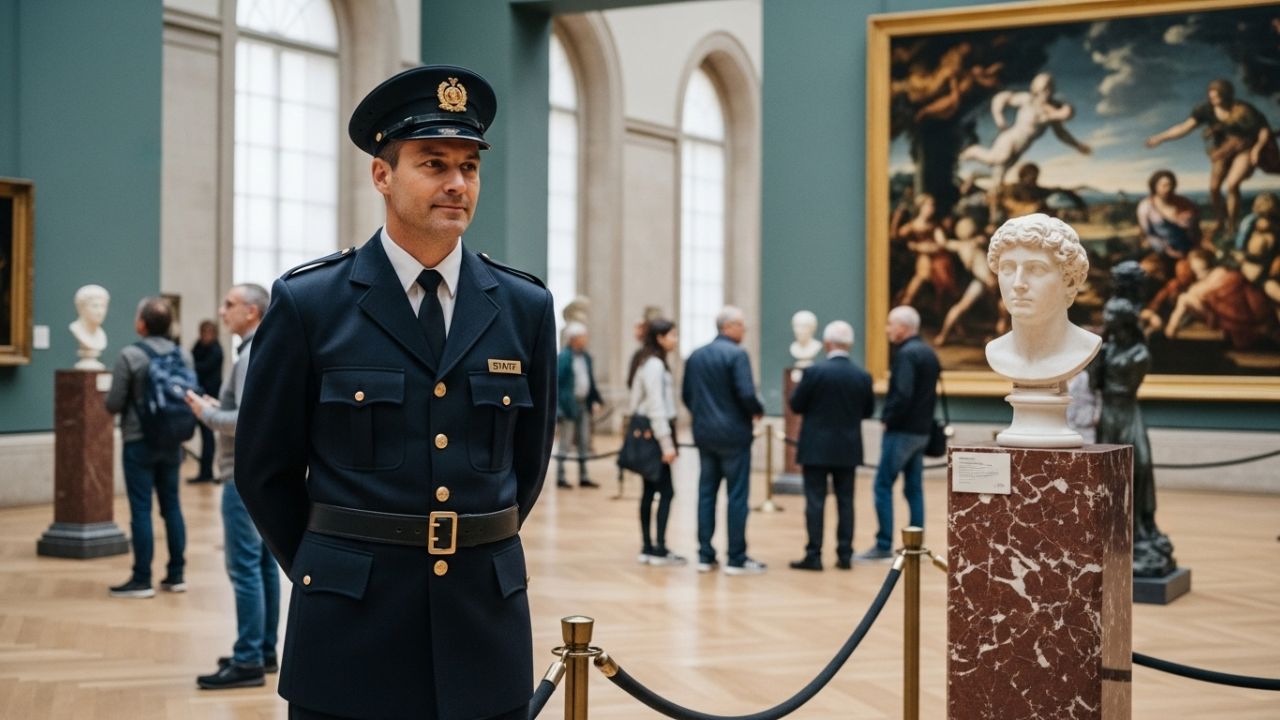Imagine stepping into a world where history, art, and culture come alive. Museums are sanctuaries of knowledge and creativity, drawing visitors from all walks of life. But behind the serene atmosphere lies a crucial element that ensures everything runs smoothly: museum security guards. The museumsaufsicht job is not just about keeping an eye on priceless artifacts; it’s about creating a safe environment for exploration and engagement.
In this post, we’ll delve deep into the multifaceted role of museum security guards. We’ll explore their challenges and highlight the importance of balancing safety with an enriching visitor experience. As we uncover effective strategies employed by successful institutions, you’ll see how these unsung heroes keep both artwork and audiences protected while fostering an inviting atmosphere for all who enter. Join us on this journey to understand what makes the museumsaufsicht job so vital in today’s cultural landscape!
The Role of a Museum Security Guard
Museum security guards serve as the first line of defense for priceless treasures. They are tasked with protecting valuable artifacts, ensuring that each piece remains unharmed while on display. Their role extends beyond mere surveillance. These professionals engage with visitors, offering assistance and answering questions to enhance the overall experience. A friendly face can turn a simple visit into an enlightening journey.
Additionally, they monitor crowd behavior to prevent any potential incidents. By maintaining vigilance, they help deter theft or vandalism while fostering a respectful environment for art appreciation. Security guards also play an essential part in emergency preparedness. Whether it’s guiding guests during evacuations or responding to medical emergencies, their training equips them for various scenarios that may arise within museum walls.
The effectiveness of museum security guards lies in their ability to blend safety protocols with enriching visitor interactions—creating a secure yet welcoming atmosphere for all who enter these cultural havens.
Challenges Faced by Museum Security Guards
Museum security guards face a unique set of challenges in their daily roles. The pressure to protect valuable artifacts can be overwhelming. These items are not just possessions; they hold historical and cultural significance. Balancing vigilance with approachability is another hurdle. Guards must remain alert while also ensuring that visitors feel comfortable exploring the space. A stern demeanor can deter engagement, but a relaxed attitude may compromise security.
Crowds present additional difficulties. High visitor numbers during exhibitions or events increase the complexity of monitoring areas effectively. This often leads to strained resources and heightened stress levels for guards on duty. Moreover, technology introduces both solutions and complications. While modern surveillance systems enhance safety, they require continuous training and adaptation as new tools emerge. Each day brings different scenarios, demanding flexibility and quick decision-making from those on the front lines of museum security.
Importance of Balancing Security and Visitor Experience
Balancing security and visitor experience in museums is crucial for fostering a welcoming atmosphere while ensuring the safety of priceless artifacts. Without this balance, visitors may feel uneasy or restricted, diminishing their overall enjoyment of cultural exhibits. A secure environment allows guests to explore freely, knowing that both they and the artwork are protected. This reassurance enhances engagement with displays and encourages deeper appreciation of art and history.
Moreover, effective security measures can blend seamlessly into the background. Thoughtful design choices allow staff to monitor without intruding on guests’ experiences.
By prioritizing a harmonious relationship between protection protocols and visitor enjoyment, museums can cultivate an enriching space where art thrives alongside human connection. Visitors should leave not only informed but also inspired by what they’ve seen not burdened by concerns over safety.
Strategies for Achieving Balance
Creating a harmonious environment in museums requires innovative strategies. One effective approach involves training security personnel to engage positively with visitors. By fostering communication skills, guards can create an approachable atmosphere while maintaining vigilance. Implementing technology also plays a crucial role. Surveillance systems equipped with advanced analytics enable staff to monitor activities without being intrusive. This allows for quick responses to potential issues without disrupting the visitor experience.
Regular feedback from both staff and patrons is invaluable. Understanding visitor concerns helps fine-tune security measures that align with public expectations. Involving museum guides in safety protocols promotes teamwork between departments. When everyone shares responsibility for both safety and enjoyment, the entire experience improves for visitors and staff alike.
Training and Qualifications for Museum Security Guards
Training for museum security guards is more than just learning to monitor entrances and exits. It involves understanding the unique environment of a museum, where art and artifacts demand special handling. Most museums require security personnel to complete specific training programs that cover emergency procedures, theft prevention, and how to interact with visitors. Knowledge of art history or familiarity with the exhibits can enhance a guard’s ability to engage meaningfully with guests.
Certification in first aid and CPR is often mandatory. This ensures they are prepared for medical emergencies while on duty.
Additionally, soft skills play a crucial role in this profession. Effective communication helps guards manage crowds without causing disruption. Empathy enables them to appreciate the visitor experience while maintaining safety protocols.
Continuous education through workshops keeps security staff updated on best practices in both security measures and customer service within cultural institutions.
Case Studies: Successful Examples of Balancing Security and Visitor Experience in Museums
One notable case is the Louvre in Paris. The museum implemented a dual approach to security that emphasizes visitor engagement. By using unobtrusive surveillance technology, they maintain safety while allowing guests to freely appreciate art. The British Museum also excels in this area. Their guards undergo extensive training not only in security protocols but also in customer service. This helps them interact positively with visitors, ensuring a welcoming atmosphere alongside robust safety measures.
In the United States, The Getty Center employs art historians as part of their security team. These professionals offer insights into exhibitions while monitoring surroundings, bridging the gap between protection and education seamlessly. Each example highlights innovative strategies that prioritize both security and enhancing the visitor experience, proving that these goals can coexist harmoniously within museum settings.
Conclusion
The role of a museum security guard is multifaceted. These professionals are not just enforcers of rules; they play an essential part in enhancing the overall visitor experience. By striking a balance between security and engagement, museums can provide both safety and enjoyment. Challenges abound in this field. From handling large crowds to managing potential threats, museum security guards face unique situations daily. Yet, these challenges offer opportunities for growth and innovation in visitor interaction.
Balancing the need for protection with a welcoming atmosphere is crucial. Museums thrive on public engagement, but without robust security measures, their valuable collections remain at risk. With well-planned strategies such as proactive communication and visible presence, museums can create an environment that feels safe yet inviting. Investing in technology also helps streamline processes while maintaining human interactions an essential factor when it comes to visitor comfort.
Training plays a significant role too. Security personnel must possess strong observational skills along with knowledge about art preservation techniques and customer service practices. This comprehensive training helps them navigate complex scenarios effectively while ensuring visitors have memorable experiences. Successful case studies show that finding this balance yields positive results for both staff and patrons alike. Whether through community events or engaging guided tours led by knowledgeable guards, these examples highlight how integrating security within the overall museum experience enriches cultural appreciation.
A career as a museumsaufsicht job offers rewarding challenges that extend beyond traditional perceptions of law enforcement roles it embodies stewardship over priceless artifacts while fostering connection among diverse audiences.

